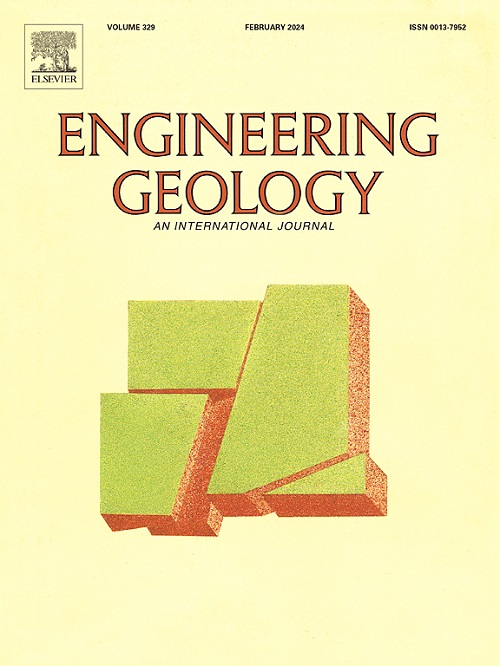Hanging wall effects on cross-fault slope failures: Shaking table experiment insights
IF 6.9
1区 工程技术
Q1 ENGINEERING, GEOLOGICAL
引用次数: 0
Abstract
Earthquake-triggered landslides are prone to occur on the hanging wall of faults, yet the failure mechanism of co-seismic landslides affected by reverse faulting remains poorly understood. In this study, we explore the dynamic response and failure mechanism of cross-fault slopes by conducting reverse fault physical modeling on large-scale shaking table model testing. A novel movable model box with a sliding bottom plate and an air cushion is used to simulate the reverse faulting of the horizontal layered slope models with fault dip angles of 30° and 50°. We analyze the effect of different reverse fault angles on the dynamic response and failure patterns, using various seismic waves, Hilbert-Huang transform (HHT), and particle image velocimetry (PIV). The results indicate that the dip angle of the reverse fault dislocation is crucial in influencing the dynamic response of the cross-fault slope. The 30° model is more sensitive to frequency changes and is prone to resonance at 24 Hz, while the 50° model produces stronger dynamic response to high amplitude seismic waves. Reverse fault dislocation amplifies the dynamic response and Hilbert energy at the hanging wall, with a larger amplification coefficient observed at a 30° dip angle. Slope models with different dip angles of the reverse fault produce distinct Hilbert energy distributions, resulting in two typical failure patterns. A “tension-shear” failure pattern, characterized by a shallow sliding surface, occurs in the 50° dip angle model, while a “tension-ejection” failure pattern with a vertical tensile sliding surface occurs in the 30° dip angle model. Our results provide important insights into the behavior of cross-fault slopes during seismic events, and provide guidance for better understanding and managing hazards associated with cross-fault slopes.
上盘对断层间边坡破坏的影响:振动台试验见解
地震诱发滑坡多发生在断层上盘,但对逆断层作用下同震滑坡的破坏机制尚不清楚。本研究通过大型振动台模型试验进行逆断层物理模拟,探讨断层间边坡的动力响应及破坏机制。采用一种新颖的带滑动底板和气垫的可移动模型箱,模拟了断层倾角为30°和50°的水平层状边坡模型的反向断裂。利用不同的地震波、Hilbert-Huang变换(HHT)和粒子图像测速(PIV)技术,分析了不同逆断层角度对断层动力响应和破坏模式的影响。结果表明,逆断层位错的倾角对跨断层边坡的动力响应有重要影响。30°模型对频率变化更敏感,在24 Hz时容易产生共振,而50°模型对高振幅地震波产生更强的动力响应。逆断层位错放大了上盘的动力响应和希尔伯特能量,且在30°倾角处放大系数较大。逆断层不同倾角的边坡模型产生不同的希尔伯特能量分布,形成两种典型的破坏模式。在50°倾角模型中出现了以浅层滑动面为特征的“张剪”破坏模式,而在30°倾角模型中出现了以垂直拉伸滑动面为特征的“张射”破坏模式。我们的研究结果对地震事件中断层间斜坡的行为提供了重要的见解,并为更好地理解和管理与断层间斜坡相关的灾害提供了指导。
本文章由计算机程序翻译,如有差异,请以英文原文为准。
求助全文
约1分钟内获得全文
求助全文
来源期刊

Engineering Geology
地学-地球科学综合
CiteScore
13.70
自引率
12.20%
发文量
327
审稿时长
5.6 months
期刊介绍:
Engineering Geology, an international interdisciplinary journal, serves as a bridge between earth sciences and engineering, focusing on geological and geotechnical engineering. It welcomes studies with relevance to engineering, environmental concerns, and safety, catering to engineering geologists with backgrounds in geology or civil/mining engineering. Topics include applied geomorphology, structural geology, geophysics, geochemistry, environmental geology, hydrogeology, land use planning, natural hazards, remote sensing, soil and rock mechanics, and applied geotechnical engineering. The journal provides a platform for research at the intersection of geology and engineering disciplines.
 求助内容:
求助内容: 应助结果提醒方式:
应助结果提醒方式:


